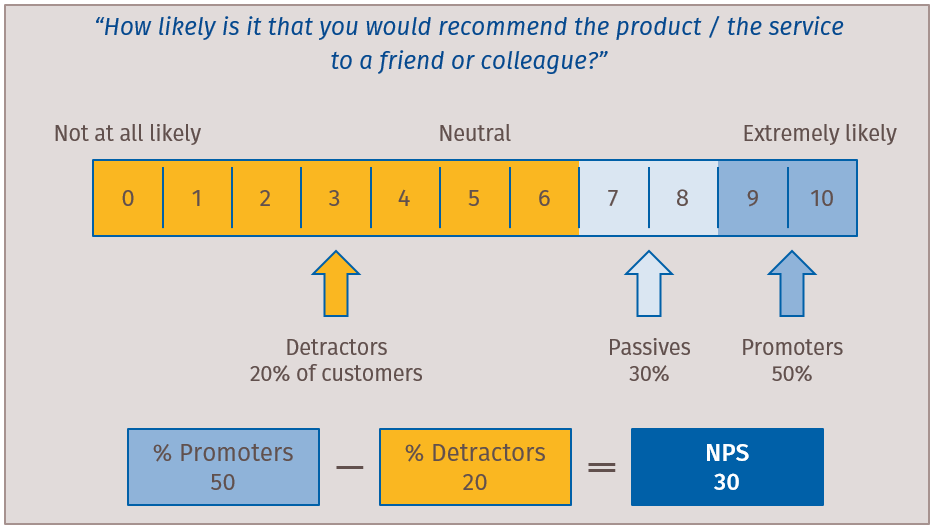 Just recently at the coffee machine. “Good to see you here“. It’s Friday afternoon. Why on earth did I have to grab another coffee. For certain, my boss needs something extremely important, utmost urgent, the earlier the better, at the latest by Monday morning. “The NPS of your product is splendid. It was highlighted in today's management meeting.” Hold on. Have I got it right? No global economy impacting action which ruins my weekend, instead a rare praise? – Indeed, it's a praise and it is well-deserved. NPS stands for Net Promoter Score and is a metric for customer experience. The score is determined based on a poll asking a specific question to customers: “How likely is it that you would recommend the product / the service The answer is a number between 0 and 10 and covers the range from ‘not at all likely’ to ‘extremely likely’. The calculation of the NPS is done in the following way:
The following picture illustrates the concept: Referring the question to the recommendation level of a customer yields better results compared to asking for the customer satisfaction level. A satisfied person tends to be lazy. Things are quite OK and problems are minor. Hopefully it remains like that also in future. However, competition is not far away and, in general, a satisfied customer is receptive to attractive offers. Things are different when a customer is ready to recommend a product. The customer is excited about the product and does not keep the excitement for him or herself, rather tells about the great product to friends, places excellent ratings in portals and social media. Competition is out of the game. The customer is loyal and faithful. Hence, obtaining excited customers is one of the ultimate goals for every enterprise. The Product Manager will be glad about this intention. Detractors are dangerous. Not only they discourage others from buying the product, they also damage the reputation. They churn to competitors at the next opportunity and never return. A Product Manager is advised to consider carefully the criticized items and to remove those if the blame is justified. Allocating the values 0 through 6 to the group of Detractors takes account of negative propaganda outweighing a positive one. The crucial point of the method is the customer poll. Which customers to ask, how to do it and at what time are some of the questions which need to be carefully clarified before the poll starts. The amount of answers should be representative for the customer community. There might be additional questions e.g. “Why have you given that score?”. Do not adapt the poll if the evolution of the NPS over time is required. Concerning the outcome a single NPS value does not say much. The tendency is more important. The assessment depends on the industry and the circumstances and should be determined case by case. Wow, the NPS of my product went up to 51. Finally I’m having a striking argument for the overdue raise of my salary. “By the way, boss, what do you think about …”. Off he is around the corner. I still hear him say “I’m already overdue to pick up my wife”. Also a striking argument. Well, I’d then need to wait for another opportunity to talk to him about my salary raise. Could try to catch him when he grabs a coffee which happens five times a day at least. Could start with “Good to see you here”. However, there shouldn’t be other people around which happens zero times a day. I’d better do it differently. Gosh, it’s starting to ruin my weekend …
Here my recommendation: Increase your skills of market management. RealSkills will help you. How likely is it that you would recommend this blog to a friend or colleague? Kind thanks for your score. I look forward to it - ressenig@realskills.de |



